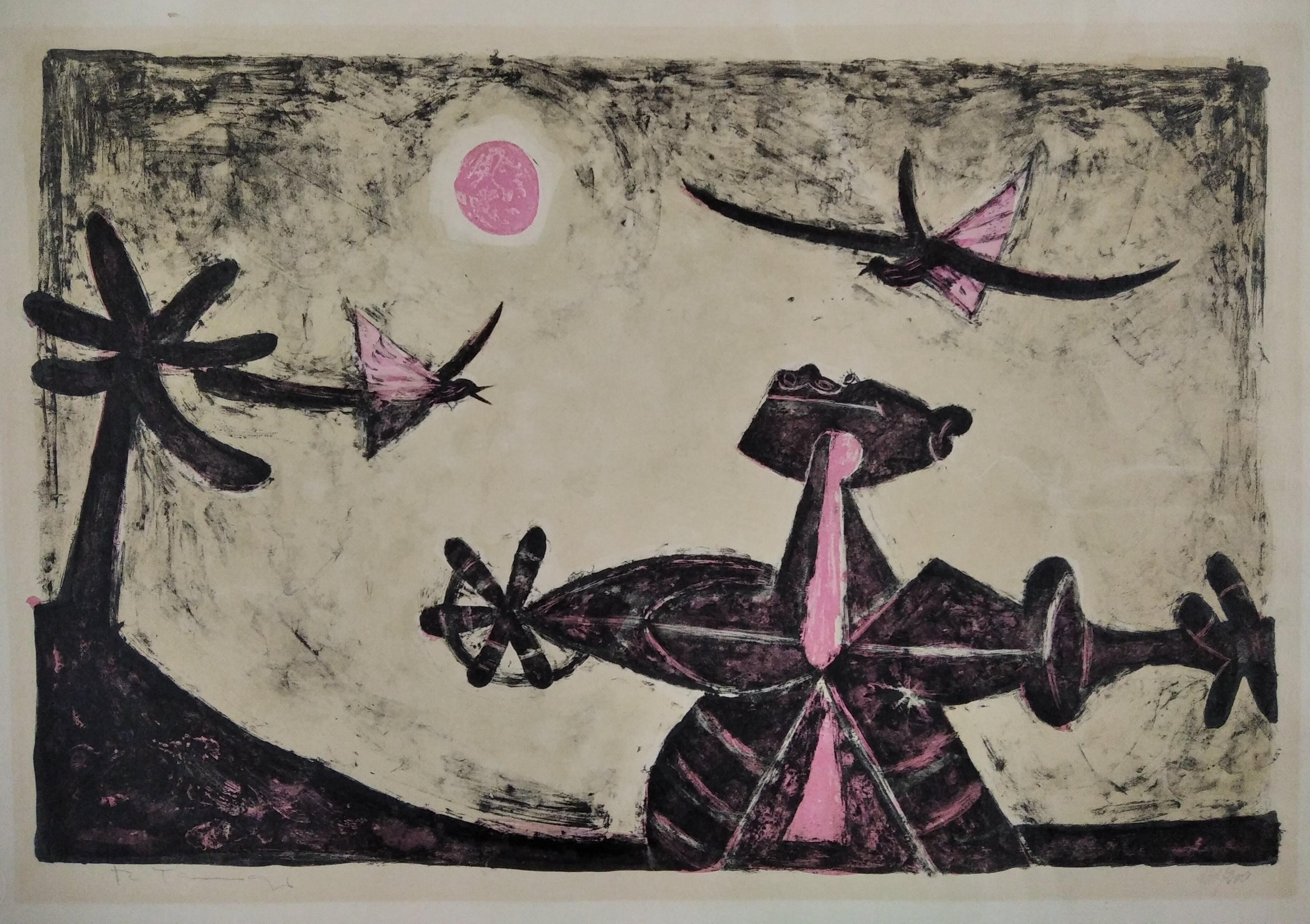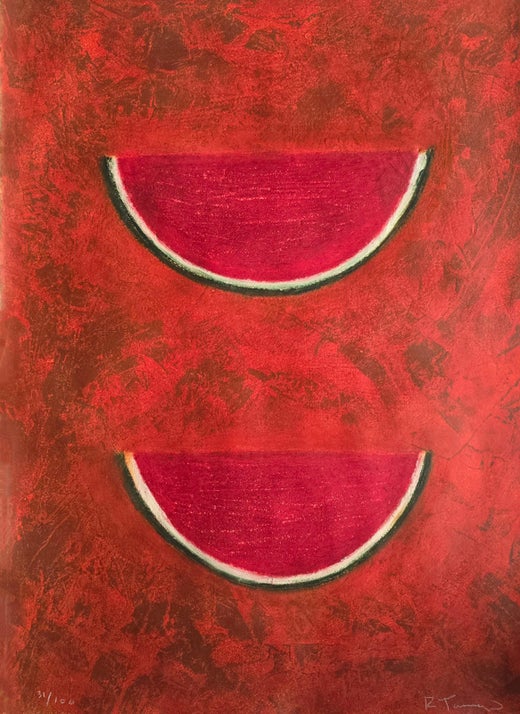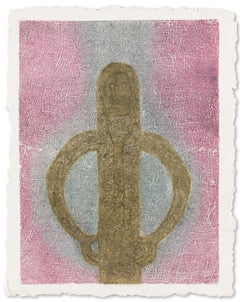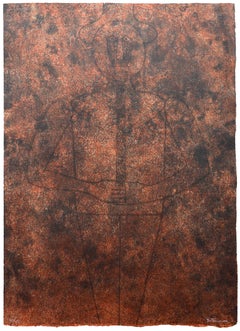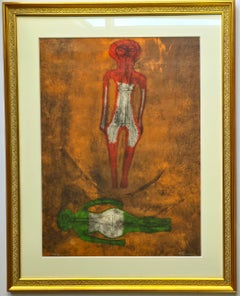Want more images or videos?
Request additional images or videos from the seller
1 of 10
Rufino TamayoCarnavalesque1969
1969
Price Upon Request
Price Upon Request
Price Upon Request
Price Upon Request
Price Upon Request
Price Upon Request
Price Upon Request
Price Upon Request
Price Upon Request
Price Upon Request
Shipping
Retrieving quote...The 1stDibs Promise:
Authenticity Guarantee,
Money-Back Guarantee,
24-Hour Cancellation
About the Item
This artwork titled "Carnavalesque" from the suite "The Mujeres File" 1969 is an original colors lithograph on BFK Rives paper by renown Mexican artist Rufino Tamayo, 1899-1991. It is hand signed and numbered 83/150 in pencil by the artist. The image size is 27.25 x 21 inches, sheet size is 30 x 22.5 inches. Published by Touchtone Publisher, New York, printed by Ateliers Desjobert, Paris. Referenced and pictured in the artist's catalogue raisonne by Pereda, plate #114 page 110. It is in excellent condition, has never been framed.
About the artist:
A native of Oaxaca in Southern Mexico, Rufino Tamayo's father was a shoemaker, and his mother a seamstress. Some accounts state that he was descended from Zapotec Indians, but he was actually 'mestizo' - of mixed indigenous/European ancestry. (Santa Barbara Museum of Art). He began painting at age 11. Orphaned at the age of 12, Tamayo moved to Mexico City, where he was raised by his maternal aunt who owned a wholesale fruit business.
In 1917, he entered the San Carlos Academy of Fine Arts, but left soon after to pursue independent study. Four years later, Tamayo was appointed the head designer of the department of ethnographic drawings at the National Museum of Archaeology in Mexico City. There he was surrounded by pre-Colombian objects, an aesthetic inspiration that would play a pivotal role in his life. In his own work, Tamayo integrated the forms and tones of pre-Columbian ceramics into his early still lives and portraits of Mexican men and women.
In the early 1920s he also taught art classes in Mexico City's public schools. Despite his involvement in Mexican history, he did not subscribe to the idea of art as nationalistic propaganda. Modern Mexican art at that time was dominated by 'The Three Great Ones' : Diego Rivera, Jose Clemente Orozco, and David Alfaro Siqueros, but Tamayo began to be noted as someone 'new' and different' for his blending of the aesthetics of post Revolutionary Mexico with the vanguard artists of Europe and the United States.
After the Mexican Revolution, he focused on creating his own identity in his work, expressing what he thought was the traditional Mexico, and refusing to follow the political trends of his contemporary artists. This caused some to see him as a 'traitor' to the political cause, and he felt it difficult to freely express himself in his art. As a result, he decided to leave Mexico in 1926 and move to New York, along with his friend, the composer Carlos Chavez. The first exhibition of Tamayo's work in the United States was held at the Weyhe Gallery, New York, in that same year. The show was successful, and Tamayo was praised for his 'authentic' status as a Mexican of 'indigenous heritage', and for his internationally appealing Modernist aesthetic. (Santa Barbara Museum of Art).
Throughout the late thirties and early forties New York's Valentine Gallery gave him shows. For nine years, beginning in 1938, he taught at the Dalton School in New York.
In 1929, some health problems led him to return to Mexico for treatment. While there he took a series of teaching jobs. During this period he became romantically involved with the artist Maria Izquierdo, with whom he lived and worked for several years. In 1933 he completed his first successful mural commission, a series of wall paintings for the Escuela Nacional de Musica (National School of Music). While working on this project, he met Olga Flores Rivas, a piano student at the school. Soon he separated from Izquierdo, and began a romance with Olga. The two were married in 1934. Although Olga was talented and had a budding performance career, she abandoned her musical pursuits to devote herself to promoting Tamayo's work. She was a lifelong muse to the artist, and over his seventy year career, he drew and painted many portraits of her.
They moved to New York in 1937, and he began to exhibit his work internationally. From 1937 to 1949, Tamayo and Olga lived there, and he became widely recognized for his signature form of abstract figuration. Some of his most valuable works were created during that time.
In 1943 Tamayo painted his first mural in the United States at the Hillyer Art Library at Smith College. Vogue magazine's 1946 issue referred to him as 'the best of young painters'. Look magazine also named him 'a fixed star in the New York art world'. (Santa Barbara Museum of Art) He was an elegant and media-savvy man, often photographed in his Upper East Side studio, with its wall of windows facing out onto Manhattan's fashionable townhouses.
The 1940s were however not without problems for the couple. Olga suffered from health problems, leading to several miscarriages, and the marriage was strained. Tamayo dedicated his work to her by adding an extra 'O' to his signature.
His fame was growing in Mexico. In 1948 his first major retrospective was held at the Palacio de Bellas Artes in Mexico City, and while he was still controversial, his popularity was high. He enjoyed broad commercial and critical success, but remained uncomfortable with the political differences and controversy, and so Tamayo and Olga moved to Paris in 1949. There he was welcomed by the artists and intellectuals of Europe. The French government named him Chevalier and Officier de la Légion d'Honneur in 1956 and 1969, respectively, and he was the recipient of numerous other honors and awards. Tamayo was among the first Mexican artists to be included in the Venice Biennale. He remained in Paris for 10 years, after which the couple returned permanently to Mexico.
His work was exhibited internationally in group and solo shows. Important Tamayo retrospectives took place at the São Paulo Bienal in 1977 and the Solomon R. Guggenheim Museum, New York, in 1979.
From 1933 to 1980, Tamayo painted 21 murals for an array of universities, libraries, museums, civic and corporate clients, hotels and an ocean liner. He was also an influential printmaker, and, in the latter part of his life embarked on the creation of sculpture. Tamayo eschewed the highly politicized themes explored within the works of his peers, and favored lyrical imagery and incorporated elements of Cubism, Surrealism and Expressionism. Mexican folklore and his Indian origins provided a constant source of inspiration for him.
Through his 70s and 80s he continued to be a prolific artist, teacher, and collector. Critics have extolled his bold and saturated use of color as his most significant contribution to Modern art. He was elected an honorary member of the American Academy and National Institute of Arts and Letters in 1961.
Rufino and Olga Tamayo donated the Museum of Pre-Hispanic Mexican Art to their native State of Oaxaca in 1974. Their personal holdings of more than 1,000 pieces of ceramics and sculpture formed the cornerstone of the collection. The Rufino Tamayo Museum of International Contemporary Art opened in Mexico in 1981, and it displays many of the artist's works, as well as paintings, sculpture and drawings from his private collection. At the time, it was the first major museum not run by the Government.
Tamayo painted his last painting in 1989, at the age of 90, 'Hombre Con Flor' (Man withFlower), a self-portrait. Rufino Tamayo died in 1991 at the age of 92 in Mexico City. Olga passed away two and a half years later.
The work of Rufino Tamayo is held in major collections and numerous museums worldwide.
- Creator:Rufino Tamayo (1899-1991, Mexican)
- Creation Year:1969
- Dimensions:Height: 30 in (76.2 cm)Width: 22.5 in (57.15 cm)Depth: 0.01 in (0.26 mm)
- Medium:
- Movement & Style:
- Period:
- Condition:
- Gallery Location:San Francisco, CA
- Reference Number:Seller: tam/tor/muj/031stDibs: LU666315213032
Rufino Tamayo
Rufino Tamayo was born in Oaxaca, Mexico, in 1899 to parents Manuel Arellanes and Florentina Tamayo. Tamayo was active in the mid-20th century in Mexico and New York, painting figurative abstraction with surrealist influences. Although Tamayo studied drawing at the Academy of Art at San Carlos as a young adult, he became dissatisfied and eventually decided to study on his own.
About the Seller
5.0
Platinum Seller
Premium sellers with a 4.7+ rating and 24-hour response times
Established in 1999
1stDibs seller since 2017
809 sales on 1stDibs
Typical response time: 1 hour
- ShippingRetrieving quote...Shipping from: San Francisco, CA
- Return Policy
Authenticity Guarantee
In the unlikely event there’s an issue with an item’s authenticity, contact us within 1 year for a full refund. DetailsMoney-Back Guarantee
If your item is not as described, is damaged in transit, or does not arrive, contact us within 7 days for a full refund. Details24-Hour Cancellation
You have a 24-hour grace period in which to reconsider your purchase, with no questions asked.Vetted Professional Sellers
Our world-class sellers must adhere to strict standards for service and quality, maintaining the integrity of our listings.Price-Match Guarantee
If you find that a seller listed the same item for a lower price elsewhere, we’ll match it.Trusted Global Delivery
Our best-in-class carrier network provides specialized shipping options worldwide, including custom delivery.More From This Seller
View AllTorso de Mujer
By Rufino Tamayo
Located in San Francisco, CA
This artwork titled "Torso de Mujer (Torso de Femmee)" from the suite "The Mujeres File" 1969 is an original colors lithograph on Wove paper by renown Mexican artist Rufino Tamayo, 1899-1991. It is hand signed and inscribed H.C. (Hors Commerce) in pencil by the artist. The image size is 26.85 x 21 inches, framed size is 40.75 x 33 inches. Published by Touchtone Publisher, New York, printed by Ateliers Desjobert, Paris. Referenced and pictured in the artist's catalogue raisonne by Pereda, plate #108 page 107. Custom framed in a wooden gold frame, with gold bevel and light beige fabric matting. It is in excellent condition.
About the artist:
A native of Oaxaca in Southern Mexico, Rufino Tamayo's father was a shoemaker, and his mother a seamstress. Some accounts state that he was descended from Zapotec Indians, but he was actually 'mestizo' - of mixed indigenous/European ancestry. (Santa Barbara Museum of Art). He began painting at age 11. Orphaned at the age of 12, Tamayo moved to Mexico City, where he was raised by his maternal aunt who owned a wholesale fruit business.
In 1917, he entered the San Carlos Academy of Fine Arts, but left soon after to pursue independent study. Four years later, Tamayo was appointed the head designer of the department of ethnographic drawings at the National Museum of Archaeology in Mexico City. There he was surrounded by pre-Colombian objects, an aesthetic inspiration that would play a pivotal role in his life. In his own work, Tamayo integrated the forms and tones of pre-Columbian ceramics...
Category
Mid-20th Century Modern Figurative Prints
Materials
Lithograph
Mascara Roja
By Rufino Tamayo
Located in San Francisco, CA
This artwork titled "Mascara Roja" 1969 is an original colors lithograph on B.F.K. Rives paper by renown Mexican artist Rufino Tamayo, 1899-1991. It is hand signed and inscribed H.C. (Hors Commerce) in pencil by the artist. The image size is 21 x 27.25 inches, framed size is 37.25 x 42 inches. Published by Touchtone Publisher, New York, printed by Ateliers Desjobert, Paris. Referenced and pictured in the artist's catalogue raisonne by Pereda, plate #124. Custom framed in a wooden gold leaf frame, with gold and red spacer and fabric matting. It is in excellent condition.
About the artist:
A native of Oaxaca in Southern Mexico, Rufino Tamayo's father was a shoemaker, and his mother a seamstress. Some accounts state that he was descended from Zapotec Indians, but he was actually 'mestizo' - of mixed indigenous/European ancestry. (Santa Barbara Museum of Art). He began painting at age 11. Orphaned at the age of 12, Tamayo moved to Mexico City, where he was raised by his maternal aunt who owned a wholesale fruit business.
In 1917, he entered the San Carlos Academy of Fine Arts, but left soon after to pursue independent study. Four years later, Tamayo was appointed the head designer of the department of ethnographic drawings at the National Museum of Archaeology in Mexico City. There he was surrounded by pre-Colombian objects, an aesthetic inspiration that would play a pivotal role in his life. In his own work, Tamayo integrated the forms and tones of pre-Columbian ceramics into his early still lives and portraits of Mexican men and women.
In the early 1920s he also taught art classes in Mexico City's public schools. Despite his involvement in Mexican history, he did not subscribe to the idea of art as nationalistic propaganda. Modern Mexican art at that time was dominated by 'The Three Great Ones' : Diego Rivera, Jose Clemente Orozco, and David Alfaro Siqueros, but Tamayo began to be noted as someone 'new' and different' for his blending of the aesthetics of post Revolutionary Mexico with the vanguard artists of Europe and the United States.
After the Mexican Revolution, he focused on creating his own identity in his work, expressing what he thought was the traditional Mexico, and refusing to follow the political trends of his contemporary artists. This caused some to see him as a 'traitor' to the political cause, and he felt it difficult to freely express himself in his art. As a result, he decided to leave Mexico in 1926 and move to New York, along with his friend, the composer Carlos Chavez. The first exhibition of Tamayo's work in the United States was held at the Weyhe Gallery, New York, in that same year. The show was successful, and Tamayo was praised for his 'authentic' status as a Mexican of 'indigenous heritage', and for his internationally appealing Modernist aesthetic. (Santa Barbara Museum of Art).
Throughout the late thirties and early forties New York's Valentine Gallery gave him shows. For nine years, beginning in 1938, he taught at the Dalton School in New York.
In 1929, some health problems led him to return to Mexico for treatment. While there he took a series of teaching jobs. During this period he became romantically involved with the artist Maria Izquierdo...
Category
Mid-20th Century Modern Figurative Prints
Materials
Lithograph
Cabeza con Pajaros
By Rufino Tamayo
Located in San Francisco, CA
This artwork titled "Cabeza con Pajaros" 1958, is an original colors lithograph on Wove paper by renown Mexican artist Rufino Tamayo, 1899-1991. It is hand signed and numbered 273/30...
Category
Mid-20th Century Modern Figurative Prints
Materials
Lithograph
Price Upon Request
Venus Noir
By Rufino Tamayo
Located in San Francisco, CA
This artwork titled "venus Noir" from the suite "The Mujeres File" 1969 is an original colors lithograph on BFK Rives paper by renown Mexican artist Rufino Tamayo, 1899-1991. It is h...
Category
Mid-20th Century Modern Figurative Prints
Materials
Lithograph
Price Upon Request
La Negra (The Black Woman)
By Rufino Tamayo
Located in San Francisco, CA
This artwork titled "La Negra (The Black Woman)" from the suite "The Mujeres File" 1969 is an original colors lithograph on B.F.K. Rives paper by renown Mexican artist Rufino Tamayo, 1899-1991. It is hand signed and numbered 150/150 in pencil by the artist. The image size is 26.85 x 21.25 inches, sheet size is 29.5 x 22.15 inches, framed size is 42 x 35 inches. Published by Touchtone Publisher, New York, printed by Ateliers Desjobert, Paris. Referenced and pictured in the artist's catalogue raisonne by Pereda, plate #109 page 107. Custom framed in a wooden silver frame, with silver spacer and fabric matting. It is in excellent condition.
About the artist:
A native of Oaxaca in Southern Mexico, Rufino Tamayo's father was a shoemaker, and his mother a seamstress. Some accounts state that he was descended from Zapotec Indians, but he was actually 'mestizo' - of mixed indigenous/European ancestry. (Santa Barbara Museum of Art). He began painting at age 11. Orphaned at the age of 12, Tamayo moved to Mexico City, where he was raised by his maternal aunt who owned a wholesale fruit business.
In 1917, he entered the San Carlos Academy of Fine Arts, but left soon after to pursue independent study. Four years later, Tamayo was appointed the head designer of the department of ethnographic drawings at the National Museum of Archaeology in Mexico City. There he was surrounded by pre-Colombian objects, an aesthetic inspiration that would play a pivotal role in his life. In his own work, Tamayo integrated the forms and tones of pre-Columbian ceramics into his early still lives and portraits of Mexican men and women.
In the early 1920s he also taught art classes in Mexico City's public schools. Despite his involvement in Mexican history, he did not subscribe to the idea of art as nationalistic propaganda. Modern Mexican art at that time was dominated by 'The Three Great Ones' : Diego Rivera, Jose Clemente Orozco, and David Alfaro Siqueros, but Tamayo began to be noted as someone 'new' and different' for his blending of the aesthetics of post Revolutionary Mexico with the vanguard artists of Europe and the United States.
After the Mexican Revolution, he focused on creating his own identity in his work, expressing what he thought was the traditional Mexico, and refusing to follow the political trends of his contemporary artists. This caused some to see him as a 'traitor' to the political cause, and he felt it difficult to freely express himself in his art. As a result, he decided to leave Mexico in 1926 and move to New York, along with his friend, the composer Carlos Chavez. The first exhibition of Tamayo's work in the United States was held at the Weyhe Gallery, New York, in that same year. The show was successful, and Tamayo was praised for his 'authentic' status as a Mexican of 'indigenous heritage', and for his internationally appealing Modernist aesthetic. (Santa Barbara Museum of Art).
Throughout the late thirties and early forties New York's Valentine Gallery gave him shows. For nine years, beginning in 1938, he taught at the Dalton School in New York.
In 1929, some health problems led him to return to Mexico for treatment. While there he took a series of teaching jobs. During this period he became romantically involved with the artist Maria Izquierdo...
Category
Mid-20th Century Modern Figurative Prints
Materials
Lithograph
Price Upon Request
"Mujer Con Sombrero" Large lithograph
By Rufino Tamayo
Located in San Francisco, CA
This artwork titled "Mujer Con Sombrero (Woman with Hat)" 1972 is a large original colors lithograph on Arches paper by renown Mexican artist Rufino Tamayo, 1899-1991. It is hand signed and numbered 81/100. in pencil by the artist. The artwork size 36.35 x 25.85 inches, sheet size is 37.25 x 26.25 inches, framed size is 52.25 x 40.5 inches. Published by Transworld Art, New York , Printed by Bank Street Atelier, New York. Referenced and pictured in the artist's catalogue raisonne by Pereda, plate #132 page 123. Custom framed in a wooden black and silver frame, with silver bevel and fabric matting. It is in excellent condition.
About the artist:
A native of Oaxaca in Southern Mexico, Rufino Tamayo's father was a shoemaker, and his mother a seamstress. Some accounts state that he was descended from Zapotec Indians, but he was actually 'mestizo' - of mixed indigenous/European ancestry. (Santa Barbara Museum of Art). He began painting at age 11. Orphaned at the age of 12, Tamayo moved to Mexico City, where he was raised by his maternal aunt who owned a wholesale fruit business.
In 1917, he entered the San Carlos Academy of Fine Arts, but left soon after to pursue independent study. Four years later, Tamayo was appointed the head designer of the department of ethnographic drawings at the National Museum of Archaeology in Mexico City. There he was surrounded by pre-Colombian objects, an aesthetic inspiration that would play a pivotal role in his life. In his own work, Tamayo integrated the forms and tones of pre-Columbian ceramics into his early still lives and portraits of Mexican men and women.
In the early 1920s he also taught art classes in Mexico City's public schools. Despite his involvement in Mexican history, he did not subscribe to the idea of art as nationalistic propaganda. Modern Mexican art at that time was dominated by 'The Three Great Ones' : Diego Rivera, Jose Clemente Orozco, and David Alfaro Siqueros, but Tamayo began to be noted as someone 'new' and different' for his blending of the aesthetics of post Revolutionary Mexico with the vanguard artists of Europe and the United States.
After the Mexican Revolution, he focused on creating his own identity in his work, expressing what he thought was the traditional Mexico, and refusing to follow the political trends of his contemporary artists. This caused some to see him as a 'traitor' to the political cause, and he felt it difficult to freely express himself in his art. As a result, he decided to leave Mexico in 1926 and move to New York, along with his friend, the composer Carlos Chavez. The first exhibition of Tamayo's work in the United States was held at the Weyhe Gallery, New York, in that same year. The show was successful, and Tamayo was praised for his 'authentic' status as a Mexican of 'indigenous heritage', and for his internationally appealing Modernist aesthetic. (Santa Barbara Museum of Art).
Throughout the late thirties and early forties New York's Valentine Gallery gave him shows. For nine years, beginning in 1938, he taught at the Dalton School in New York.
In 1929, some health problems led him to return to Mexico for treatment. While there he took a series of teaching jobs. During this period he became romantically involved with the artist Maria Izquierdo...
Category
Mid-20th Century Modern Figurative Prints
Materials
Lithograph
Price Upon Request
You May Also Like
Personaje con Red
By Rufino Tamayo
Located in New York, NY
A very good impression of this large, color Mixografía print on handmade paper. Signed and numbered 20/100 in pencil. Printed and published by Taller de Gráfica Mexicana, Mexico City...
Category
1980s Surrealist Abstract Prints
Materials
Handmade Paper, Color
Untitled
By Rufino Tamayo
Located in Barcelona, BARCELONA
The painting is being offered with a work and authenticity certificate
Category
1990s Abstract Expressionist More Prints
Materials
Lithograph
Rufino Tamayo, "Personaje con Sombrero" 1979
By Rufino Tamayo
Located in Los Angeles, CA
"Personaje con Sombrero" is a superb figurative abstraction by the renown Mexican artist Rufino Tamayo. An aquatint and etching in colors printed on a full sheet of watermarked woven handmade paper. The full sheet measures 29 5/8 inches H. x 22 inches W. Framed dimensions are 40 3/4 inches H. x 33 inches W.
Signed "R Tamayo" and numbered "40/99" in white crayon by the artist. Printed and published by Poligrafa, Barcelona in 1979.
Rufino Tamayo (1899-1991) is a modern master whose legacy is rooted in his contributions across a variety of media, including mural and easel painting, drawing, and the graphic arts. Produced between 1925 and 1991, his graphic work includes woodcuts, lithographs, etchings, and Mixografia prints — a new technique that was developed in the early 1970s to allow him to produce his prints in relief.
Tamayo is one of the most celebrated Mexican Artists of the 20th Century. Heavily influenced by pre-Columbian art...
Category
1970s Modern Prints and Multiples
Materials
Etching, Aquatint
Rufino Tamayo -- Dos Figuras
By Rufino Tamayo
Located in BRUCE, ACT
Rufino Tamayo
Dos Figuras, 1973
Lithograph in colors
Hand-signed lower right in white crayon
Numbered 21/75 cm lower left in white crayon
Sheet size 76 x 56 cm
Frame size 98 x 80 x ...
Category
1970s Prints and Multiples
Materials
Lithograph
Cabeza Sobre Fondo Verde, Surrealist Etching by Rufino Tamayo
By Rufino Tamayo
Located in Long Island City, NY
Rufino Tamayo, Mexican (1899 - 1991) - Cabeza Sobre Fondo Verde, Portfolio: Rufino Tamayo 15 aquafuertes, Year: 1979, Medium: Etching, signed and numbered in crayon, Edition: 14/...
Category
1970s Surrealist Portrait Prints
Materials
Etching
Affiche avant Lettre (Mujer Suite), 1969 Lithograph by Rufino Tamayo
By Rufino Tamayo
Located in Long Island City, NY
Affiche avant Lettre (Mujer Suite)
Rufino Tamayo
Mexican (1899–1991)
Date: 1969
Lithograph Poster, signed in the plate
Size: 32.5 x 24 in. (82.55 x 60.96 cm)
Category
1960s Prints and Multiples
Materials
Lithograph
More Ways To Browse
Mexican Wall Plates
Pre Columbian Figure
Vintage Hand Painted Fruit Plates
Zapotec Sculpture
Jose Maria David
David Dalton
Maria Izquierdo
Olga Flor
Antique Paintings Of Apollo
Arno Breker
Black Avant Garde Hat
Canterbury Tales
Carol Henry
Coco Chanel Drawings
Dali Pantagruel
David Hockney Signed Poster
De Chirico Poster
George And Martha Washington

